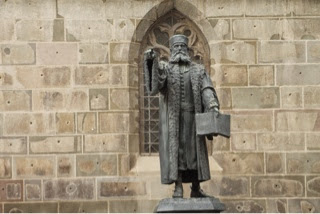Sections of the medieval wall still guard the historic area where narrow streets pass steep roofed 17th century buildings opening into church dominated squares. The large square has been designated a architectural monument by UNESCO.
I learned that courage was not the absence of fear, but the triumph over it. The brave man is not he who does not feel afraid, but he who conquers that fear. Nelson Mandela
Monday, April 21, 2014
Romania-Sibui
Saturday, April 12, 2014
Transylvania-Sighisoara
A Unesco World Heritage Site is a 15th century medieval town with nine towers, cobbled streets, burgher houses and ornate churches.
Every year in July, Sighisoara hosts the Festival of Medieval Arts and Crafts which recreates the medieval atmosphere of the town.
The Cidadel which is the UNESCO Site can be seen in about 4 hours. I suggest staying one night and then travel to Sibui and spend at least 2 nights there.
I stayed at Villa Franka on Decembre NR 1 which is across the street from the path to the citadel. It is an 1894 Villa, very comfortable with an excellent breakfast with homemade jams. Staff are very helpful.
Sites to see are: the Church on the Hill with 500 year old frescos, the Church of the Dominican monastery known for its carved altarpiece, baroque painted pulpit and it's 17th century organ and the 14th century Clock Tower (this tower controlled the main gate of the half mile long defensive wall). The Clock Tower houses the Museum of History which holds a medieval pharmacy from 1670, fine arts and a collection of clocks. There is a walk up creaking, winding staircase with views of the red-tiled roofs of the Old Town.
Walkway to CitadeL
Burgher Houses
The large Basilica along the river with view from Citadel
Church on the Hill Built in the beginning of the 13th Century. Beautiful medieval altar pieces, wall paintings and sculptures.
Clock Tower
Close up of Clock Tower
Clock Tower from the top
The Wall surrounding the Citadel
Saturday, April 5, 2014
Transylvania-Brasov
Transylvania has numerous medieval towns, spas, quaint villages and historic attractions. The region is also home to villages, churches and fortifications founded by Saxons between the 13th and 15th centuries.
First stop in Transylvania is Brasov which is surrounded br Carpathian Mountains. Brasov is definitely a storybook town with narrow cobblestone streets to stroll. The city was founded by the Teutonic Knights in 1211 and settled by the Saxons. Fortifications were erected around the city with several towers maintained by different craft guilds, according to medieval custom.
I was there for 3 nights but could easily have stayed longer as there is much to do in the surrounding area.
I rented an apartment from Select City Center apartments which was across the street from the Council Square where people gathered to walk, sit by the fountain or eat and drink at one of the cafés. The apartment was lovely, spacious and updated and very well appointed.
Train ride from Bucharest to Brasov
Street in Brasov
Council Square-beautiful place to linger in the evening.
This s the view of the cafe where I enjoyed a glass of wine, the view and the people.
View from the Square. The Church is the Black Church-the largest Gothic church east of Vienna so named because of its dark walls which survived a devastating fire in 1689. Unfortunately it was not open the days I was there.
View of the Black Church from the rear.
Statue Black Church
Clock tower Black Church
Beautiful mountain area with restaurants, lodges and hotels, walking paths.
Very quiet this time of year.
Walked to the Fortress which sits high above Brasov. It is quiets a hike, all uphill.
I used all the muscles to reach the top. Beautiful vistas overlooking Brasov.
View on the way up.
The last leg to the Fortress.
Romanian Restaurant. Excellent food and good prices.
Charming view of a complex in Brasov
St. Nicholas Church. Beautiful area with garden, cemetery and area with benches.
Just one of the story book images.
Enjoy!
Subscribe to:
Comments (Atom)


















































